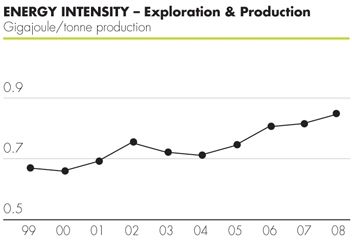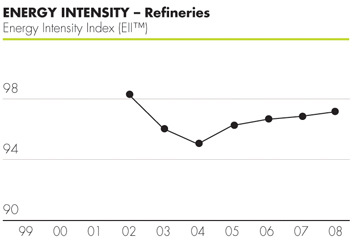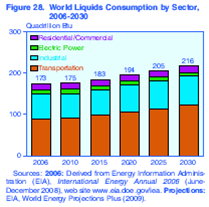Efficiency in energy usage
Jump to navigation
Jump to search
- Efficiency in energy use can be divided in two parts: Part 1: Convert primary energy into useful energy and Part 2: the Intensity of which useful energy is used to deliver services
Part 1: convert primary energy into useful energy
- Part 1: Convert primary energy into useful energy: according to shell it takes 10-15% of every barrel to make one barrel of oil. This is excluding the energy needed to produce and refine the gasoline.
- According to Shell the energy intensity of our oil production. It has risen by around 27% since 2000, there seems to be more energy needed to produce oil from aging fields and more difficult oil.
- However oil majors have been developing ways to improve the efficiency driven by the fact that oil is becoming scarce and to drive down their cost base. For example Shell, the refineries in Shell have improved their energy efficiency since 2002. These gains have come from operating refineries closer to full production capacity and running efficiency programs.
- The same can be said for BP: For example BP: in 2008 it used 0.97 billion Gigajoules (GJ) to carry out their operations which is 6% lower than in 2007 (1.03 billion GJ) while their production of oil has increased from 3,818 thousand barrels a day in 2007 to 3,838 barrels a day in 2008.
Scenario's:
Scenario 1: If instead of 10-15%, only 5% of energy will be used for producing a barrel of oil then this will save 60,000 million barrels meaning almost 2 years more of oil
Scenario 2: No efficiency increase in producing oil: within 38 years we will run out of oil
Scenario 3: Takes more energy to produce oil due to more difficult regions, 20% of energy will be used to produce oil. Then this will take up 120,000 million barrels of oil. which means our energy reserve will cut short by roughly 4 years.
Part 2: the intensity of which useful energy is used to deliver services
- The oil consumption per sector in 2010 is roughly divided as: 50% for transportation, 30% industrial, 10% residential/commercial and 10% electric power
- The oil consumption per sector in 2030 is roughly divided as: 56% for transportation, 33% industrial, 7% residential/commercial and 4% electric power
For the main sectors below is the prediction:
Industrial
- Industrial sector can be roughly divided in energy-intensive industries (iron, steel, chemicals etc) and light industries (textiles, wood etc). Energy intensive industries account for more than half of the sector’s energy consumption.
- Primary energy consumption in the industrial sector grew with 1.5% on average. (developing countries with a growth rate of 4.5%)
- Industrial sector energy efficiency is driven by lowering their production cost base. Measures have been taken to reduce energy waste, recovery energy, recycle material and use more efficient machines.
- As economies further develop there is a transition from manufacturing to service economies which use much less energy
- Average growth of energy growth for industrial sector is 1.4% to 2030.
Transportation
- Transportation: road vehicles account for about three-quarters of all transportation energy use (within this 2/3 passenger and 1/3 freight)
- Transportation is expected to go down due to advanced in communication technologies (people don’t have to travel to get things down)
- In developing countries, transportation is expected to grow, as in the countries now walking and bicycling plays an important role in transportation, with the growth in wealth, there will be an increase in personal vehicles.
- Personal vehicles are increasingly becoming more fuel efficient by reducing the load of the engine, capture energy losses etc.
* There is another trend to switch to less carbon-intensive fuels like hybrid cars. The growth of hybrid cars was 28% since 2005.
- For rail, aircraft and shipping, the efficiency has in general already improved. For example aircrafts, they are 70% more fuel-efficient per passenger kilometre compared to 40 years ago, improvements are further being researched.
Residential
- Residential/Commercial: 22% of energy goes to lightning, 42% to space heating and the rest to appliances. Major improvements in more energy residential energy use: for example: more efficient light bulbs, which uses 10 times less energy.
Scenario’s:
- Scenario 1: Consumption per sector will stay as it is
- Scenario 2: More efficient energy use in the transportation and industrial sector: 20% more efficient. 85 million barrels will be 68 billion barrels per day.
- Scenario 3: More efficient energy use in the transportation and industrial sector: 40% more efficient. 85 million barrels will be 51 billion barrels per day. Oil production
Reference
[[1]]
[[http://www.interacademycouncil.net/Object.File/Master/12/063/2.%20Energy%20Demand%20and%20Efficiency


